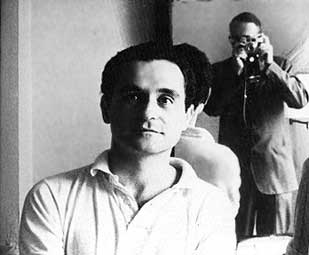 |
| Gertrude Stein: three portraits by Andy Warhol. |
Today, we'll begin by looking at another precursor to the cut-up technique from the early 20th century: Gertrude Stein's Tender Buttons (1914). Stein's work is highly repetitive, employing not only anaphora within individual pieces but a more complex interweaving of certain words and phrases throughout the book as a whole. Moreover, while we see straight iteration, in Tender Buttons we also see these phrases mutate as they're repeated, not unlike what happens when you play the game "telephone" (or "whisper down the lane"). What's most impressive is the way in which Stein prefigures highly-technical methods and tropes like Tzara, Burroughs, and Gysin's cut-ups without in any way shape or form being mechanized — it's all the stream-of-consciousness product of a highly recursive (and disinhibited) mind. You'll find the Stein readings here: [PDF]
 |
| John Giorno photographed by William S. Burroughs, 1965. |
From Stein, we'll jump forward to the 1960s for our other main reading of the day: selections from John Giorno's Subduing Demons in America (ed. Marcus Boon). Giorno was an acolyte and lifelong friend of both Burroughs and Gysin, and in his early poetry, we see him employing both the appropriation of found source texts and the collaging of these materials, however his great innovation would be in how these diverse sources would be juxtaposed: first through typographical presentation on the page and later, in live performance and on record albums, through the assistance of multitrack recordings and tape delays. You'll read a variety of poetic materials from the 1960s and 70s as well as a brief description of the "ESPEs" or "Extra-Sensory Poetry Environments" Giorno staged in the late 60s in New York City and elsewhere. Your Giorno readings are here: [PDF] and you might also want to check out his page at UbuWeb for a ton of recordings made over his long career.
We'll round out our readings by looking at a few mid-60s pieces by Ron Padgett that show the influence of Andy Warhol's artistic innovations: "Nothing in That Drawer," "Sonnet for Andy Warhol" and Two Stories for Andy Warhol (n.b. the detail shown on the linked page is one of ten identical pages from Padgett's book).
And speaking of Warhol, if you're not familiar with his work, you might want to check out this gallery that focuses specifically on his grid-based screenprint paintings. The same postmodern ideologies of theme and variation, emphasizing subtle differences over time, also greatly influenced the development of minimalism within American contemporary classical music during this era (c.f. Philip Glass or Steve Reich, who we'll be looking at later this term).

No comments:
Post a Comment